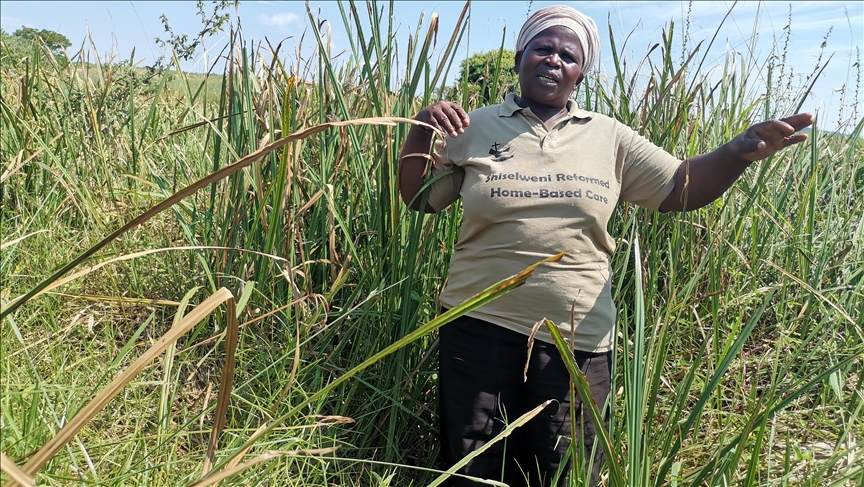Swazi rural villagers save threatened wetland
Witnessing the wetland sprouting to life and recharging with water last year brought villagers joy, surprise, and disbelief

MANZINI, Eswatini
Rural villagers rolled their sleeves amid the COVID-19 pandemic to resuscitate a wetland that dried up over three decades ago.
In the Shiselweni region, the wetland at Mgudvwini, Nsingizini chiefdom, was their important ecological resource. But, it became a parched ground due to drought, overgrazing, and irresponsible human behavior.

Africa Cooperative Action Trust (ACAT) offered assistance to protect the wetland of the community, facing the horror of drinking, sharing unsafe water with livestock and travelling long distances to harvest the special sedges.
The community's collaboration with the non-profit organization successfully restored the wetland's hydrological cycle and biodiversity.
Over 30 years of ecological misery
Chairlady of the Mgudvwini Wetland Community Project, Philiswe Gamedze, said the drying up of the wetland left them with difficult livelihoods.
"Simple things like water that we used to get easily became scarce," she said. "Drought forced us to share the only water source with livestock. The ACAT coordinator was touched when he found a dead animal next to our water source."
Gamedze recalled how the once-thriving wetland was environmentally decimated, shattering micro-scale enterprises for hundreds of women in the area who cut sedges to make sleeping grass mats which locals and tourists bought.

She explained that the ACAT project coordinator pledged rolls of the fence and barbed wire. The agreement with residents was that they would cut logs from the forest and provide labor.
However, witnessing the wetland sprouting to life and recharging with water last year brought joy, surprise, and disbelief.
"It never occurred to our minds that this wetland, after decades, will come back to life again. The youth had difficulty believing that such arid ground was once a flourishing wetland," she said.
"We are excited to have our mother nature risen from the dead. Now we harvest grass to make sleeping mats to sell at the market. We also collect special medicinal plants to treat our children," said Gamedze.
ACAT Project Coordinator Siyabonga Dlamini said his organization is encouraging communities to embark on activities that protect their wetlands.
Dlamimi said protecting the Mgudvwini water source was the starting point before fencing off the entire one-time wetland area.
"It was difficult to work because of covid-19 regulations," said Dlamini. "But through their dedication, we finished the project without incidents of infection.
According to Dlamini, over 60 households now get potable water and over 300 people harvest sedges plants from the wetland again.
However, he noted that Swazis still lack environmental education. "A challenge we have is that most Swazis are not knowledgeable about environmental stewardship. For instance, in some wetlands communities, practice agriculture right inside the wetland.
"As we educate them, they gradually understand the importance of wetlands with regards to mitigating the impacts of climate change. They are able to value the benefits of protecting these wetlands," said Dlamini.
Community wetland management plan
Eswatini Environmental Authority Communications Manager Belusile Mhlanga said they encourage communities to fence off wetlands for access control to protect them from wildfires and alien invasive species.
"Each and every homestead must know the reasons and benefits that will be accrued by protecting a wetland.
"We also encourage the reintroduction of species which have been depleted inside the wetland to allow for its propagation to restore the wetland to its former natural form," said Mhlanga.
She said the management model preferred for communities is to barricade the area and the water source outside the wetland fence.
Because people and animals should have easy access to water, the harvest of the fiber material has to be in a controlled manner.
Carbon sequestration
Conservation Biologist and University of Eswatini lecturer Themba Mahlaba said wetlands are very important in carbon sequestration.
"Wetlands' major task is the sequestration of carbon. At times it goes as far as the formation of peats and peat bogs; all of that is carbon sequestration. They harbor green plants all year round which photosynthesize carbon dioxide from the air, convert it into chlorophyll and used by the plants sustainably," he said.
American Geophysical Union (AGU) has recently published a book on "Managing Wetlands to Improve Carbon Sequestration."
According to their research: "Restoring wetlands to their original hydrology is often very difficult but doing so provides the most effective way to facilitate carbon storage, keeping in mind that much of the carbon stored in a wetland occurs belowground. Another way is to create wetlands that were previously lost; if the hydrology is sufficient, carbon storage can be facilitated."
Anadolu Agency website contains only a portion of the news stories offered to subscribers in the AA News Broadcasting System (HAS), and in summarized form. Please contact us for subscription options.

